A bigger haul this week than last, with an installment of the main Secret Wars series plus seven tie-ins from Marvel; no DC debuts, but there were eight first issues from indy publishers that caught my eye, plus the usual suspects from ongoing books. Come by the brand-new All About store at 24 W. Camelback and check these out:
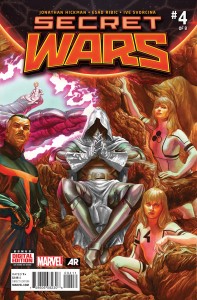 Secret Wars #4 — Writer: Jonathan Hickman; Art: Esad Ribic; Colors: Ive Svorcina
Secret Wars #4 — Writer: Jonathan Hickman; Art: Esad Ribic; Colors: Ive Svorcina
Secret Wars: Red Skull #1 (of 3) — Writer: Joshua Williamson; Art: Luca Pizzari; Colors: Rainier Beredo
Secret Wars: A-Force #2 (of 5) — Writers: Marguerite Bennett and G. Willow Wilson; Pencils: Jorge Molina; Inks: Craig Young and Walden Wong; Colors: Lauras Martin
Secret Wars Future Imperfect #2 ( of 5) — Writer: Peter David; Art: Greg Land; Inks: Jay Leisten; Colors: Nolan Woodard
 Secret Wars: Giant-Size Little Marvel #2 (of 4) — Writer/Artist: Skottie Young; Colors: Jean-Francois Beaulieu
Secret Wars: Giant-Size Little Marvel #2 (of 4) — Writer/Artist: Skottie Young; Colors: Jean-Francois Beaulieu
Secret Wars Journal #3 (of 5) — (First Story): Writer: Frank Tieri; Art: Richard Isanove; (Second Story): Writer: Scott Aukerman; Art: RB Silva; Colors: Guru-eFX
Secret Wars: Ultimate End #3 (of 5) — Writer: Brian Michael Bendis; Pencils: Mark Bagley; Inks: Scott Hanna; Colors: Justin Ponsor
Secret Wars: X-Tinction Agenda: Writer: Marc 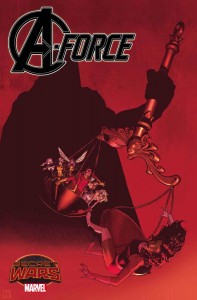 Guggenheim; Art: Carmine Di Giandomenico; Colors: Nolan Woodard
Guggenheim; Art: Carmine Di Giandomenico; Colors: Nolan Woodard
With Secret Wars at its halfway point with this issue, it’s becoming clear that Hickman is really writing a Fantastic Four story: it’s now a Doom vs. Reed Richards fight, with Victor’s omnipotence undermined by his petty jealousy of, and obsession with besting, his old rival. OK by me — Hickman spent a long time writing those characters during his FF run a few years ago, and knows them intimately; that lends a classical-tragedy resonance to the plot that promises to energize this summer event’s 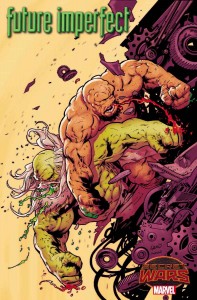 second half. Meanwhile, the only first issue of the tie-ins is Red Skull #1, as that old bad guy (and rival of Doom’s) has tried to lead a revolt and ended up exiled in the zombie-invested lands beyond the Shield of Battleworld. However, there are rumors of his survival, and so a motley crew of adventurers (Elektro, Lady Deathstrike, Moonstone, Jack O’Lantern, Winter Soldier and Magneto) are recruited to investigate; of course, things go badly. Pizzari has a loose, interesting style that’s reminiscent of Frank Robbins (although the dark-hued coloring doesn’t do it any favors), and the story ends up with an old-school Super-Villain Team-Up vibe that keeps it readable. A-Force continues its
second half. Meanwhile, the only first issue of the tie-ins is Red Skull #1, as that old bad guy (and rival of Doom’s) has tried to lead a revolt and ended up exiled in the zombie-invested lands beyond the Shield of Battleworld. However, there are rumors of his survival, and so a motley crew of adventurers (Elektro, Lady Deathstrike, Moonstone, Jack O’Lantern, Winter Soldier and Magneto) are recruited to investigate; of course, things go badly. Pizzari has a loose, interesting style that’s reminiscent of Frank Robbins (although the dark-hued coloring doesn’t do it any favors), and the story ends up with an old-school Super-Villain Team-Up vibe that keeps it readable. A-Force continues its 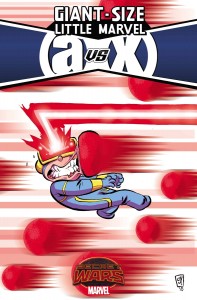 look at a number of female heroes working together — She-Hulk, Medusa, Dazzler, Captain Marvel, Nico from Runaways, a mute and mysterious newcomer, and others — and offers a lot of good characterization, quite a bit of action and teamwork, and the promise of a lot more issues, since this will be one of the books that continues after Secret Wars, and is part of Marvel’s new relaunch in September (co-writer Wilson will continue as scripter, although there hasn’t been any announcement about the artist yet). Future Imperfect has Peter David returning to his Hulk roots, specifically the evil
look at a number of female heroes working together — She-Hulk, Medusa, Dazzler, Captain Marvel, Nico from Runaways, a mute and mysterious newcomer, and others — and offers a lot of good characterization, quite a bit of action and teamwork, and the promise of a lot more issues, since this will be one of the books that continues after Secret Wars, and is part of Marvel’s new relaunch in September (co-writer Wilson will continue as scripter, although there hasn’t been any announcement about the artist yet). Future Imperfect has Peter David returning to his Hulk roots, specifically the evil  future-Banner version called the Maestro (with another old David character making a surprise appearance, too), and offers the excitement of a Thing/Hulk fight; artist Land, who’s known for copying/tracing photos and other sources, goes to that well a little too often here, since the fight itself is mostly a selection of old John Buscema Thing/Hulk poses that look good on the page, but will be jarringly-familiar enough for old fans to shake them out of the story. No worries about copying with Giant-Size Little Marvel, since writer/artist Young has a style uniquely his own; his bigfoot/Peanuts version of the Avengers and X-Men as little kids is brightly-colored, energetic fun that should appeal to younger and older readers alike. Secret Wars Journal is an anthology title with two ten-page tales; the
future-Banner version called the Maestro (with another old David character making a surprise appearance, too), and offers the excitement of a Thing/Hulk fight; artist Land, who’s known for copying/tracing photos and other sources, goes to that well a little too often here, since the fight itself is mostly a selection of old John Buscema Thing/Hulk poses that look good on the page, but will be jarringly-familiar enough for old fans to shake them out of the story. No worries about copying with Giant-Size Little Marvel, since writer/artist Young has a style uniquely his own; his bigfoot/Peanuts version of the Avengers and X-Men as little kids is brightly-colored, energetic fun that should appeal to younger and older readers alike. Secret Wars Journal is an anthology title with two ten-page tales; the 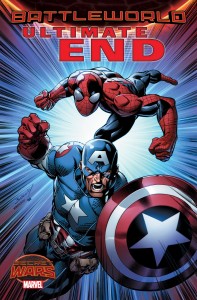 first is a murder mystery, with Wolverine as a hard-boiled private eye investigating the death of Tony Stark (well, a Tony Stark…) and Isanove’s detailed, good-looking art helps it considerably. The second story focuses on Doc Samson, a psychologist in a land where lots of the inhabitants have been affected by gamma rays, making them prone to Hulking out and requiring his anger-management skills so they don’t all destroy each other; that’s a premise just interesting enough for its ten pages. Ultimate End continues its swan song for the Ultimate universe, as many of those characters are living in a New York City mashed together with “our” versions of themselves, and it turns out that two Bruce Banners, and two Tony Starks, can cause quite a bit of trouble.
first is a murder mystery, with Wolverine as a hard-boiled private eye investigating the death of Tony Stark (well, a Tony Stark…) and Isanove’s detailed, good-looking art helps it considerably. The second story focuses on Doc Samson, a psychologist in a land where lots of the inhabitants have been affected by gamma rays, making them prone to Hulking out and requiring his anger-management skills so they don’t all destroy each other; that’s a premise just interesting enough for its ten pages. Ultimate End continues its swan song for the Ultimate universe, as many of those characters are living in a New York City mashed together with “our” versions of themselves, and it turns out that two Bruce Banners, and two Tony Starks, can cause quite a bit of trouble.  Bendis and Bagley made the Ultimate Universe 15 years ago (their first couple of years on Ultimate Spider-Man ranks as one of the best superhero runs of the early ’00s), and watching them take a last look at these people (their Samuel L. Jackson version of Nick Fury, especially) makes this the best tie-in of the week’s. That leaves X-Tinction Agenda, an absolutely typical example of the Secret Wars idea — take an earlier period of a book’s run, in this case the 1990 X-Men crossover of the same name, involving the mutant-hating, Nazi-ish nation of Genosha, and run with it. Fine, and if you’re a certain age those 25-year-old books might hold a lot of fond memories although the mileages of differently-aged readers may vary.
Bendis and Bagley made the Ultimate Universe 15 years ago (their first couple of years on Ultimate Spider-Man ranks as one of the best superhero runs of the early ’00s), and watching them take a last look at these people (their Samuel L. Jackson version of Nick Fury, especially) makes this the best tie-in of the week’s. That leaves X-Tinction Agenda, an absolutely typical example of the Secret Wars idea — take an earlier period of a book’s run, in this case the 1990 X-Men crossover of the same name, involving the mutant-hating, Nazi-ish nation of Genosha, and run with it. Fine, and if you’re a certain age those 25-year-old books might hold a lot of fond memories although the mileages of differently-aged readers may vary.
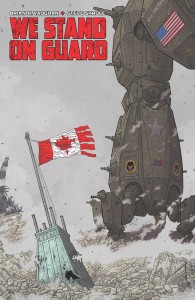 We Stand on Guard #1 — Writer: Brian K. Vaughan; Art: Steve Skroce; Colors: Matt Hollingsworth
We Stand on Guard #1 — Writer: Brian K. Vaughan; Art: Steve Skroce; Colors: Matt Hollingsworth
The Spire #1 — Writer: Simon Spurrier; Art: Jeff Stokely; Colors: Andre May
Onyx #1 — Writer: Chris Ryall; Art: Gabriel Rodriguez; Colors: Jay Fotos
18 Days #1 — Writer: Grant Morrison; Art/Colors: Jeevan J. Kang
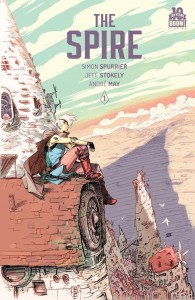 8House: Arclight #1 — Writer: Brandon Graham; Art/Colors: Marian Churchland
8House: Arclight #1 — Writer: Brandon Graham; Art/Colors: Marian Churchland
Will Eisner’s The Spirit #1 — Writer: Matt Wagner; Art: Dan Schkade; Colors: Brennan Wagner
Barb Wire #1 — Writer: Chris Warner; Pencils: Patrick Olliffe; Inks: Tom Nguyen; Colors: Gabe Eltaeb
Mickey Mouse #1 — Creators: Various
 As I said at the start, there were a lot of first issues from smaller publishers this week; certainly the most-anticipated is Brian K. Vaughan’s We Stand on Guard, since when the author of Saga, Y: The Last Man and Ex Machina begins a new series, everyone pays attention. This particular story, set 100 years in the future, is about the US declaring war on Canada, and is told from the perspective of a small group of Canadian resistance fighters. Of course, the story is well-constructed, but it looks good too — Skroce, who’s Canadian (so potentially-embarrassing errors about our neighbor to the north shouldn’t be a
As I said at the start, there were a lot of first issues from smaller publishers this week; certainly the most-anticipated is Brian K. Vaughan’s We Stand on Guard, since when the author of Saga, Y: The Last Man and Ex Machina begins a new series, everyone pays attention. This particular story, set 100 years in the future, is about the US declaring war on Canada, and is told from the perspective of a small group of Canadian resistance fighters. Of course, the story is well-constructed, but it looks good too — Skroce, who’s Canadian (so potentially-embarrassing errors about our neighbor to the north shouldn’t be a 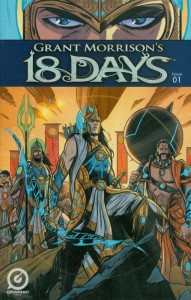 problem), has a long career working on movie storyboards, including all three Matrix movies and I, Robot, so he’s got a very clear storytelling style, and a knack for futuristic technology that serves him well. Considering the back-issue prices on first issues of Y, The Last Man and Saga, fans might want to jump on this book early. Three other debuts this week are sf, too: The Spire is about a huge, tiered, piled-up city in the middle of a desert, one ruled by a feudal system involving barons and low-tech weapons like bows and arrows; there are also shapeshifters (called “skews”) and the regular aristocrats-on-high and peons-in-the-lower-levels setup. It’s a well-realized world
problem), has a long career working on movie storyboards, including all three Matrix movies and I, Robot, so he’s got a very clear storytelling style, and a knack for futuristic technology that serves him well. Considering the back-issue prices on first issues of Y, The Last Man and Saga, fans might want to jump on this book early. Three other debuts this week are sf, too: The Spire is about a huge, tiered, piled-up city in the middle of a desert, one ruled by a feudal system involving barons and low-tech weapons like bows and arrows; there are also shapeshifters (called “skews”) and the regular aristocrats-on-high and peons-in-the-lower-levels setup. It’s a well-realized world  (one you’d expect from a seasoned writer like Spurrier), with a mysterious but kick-ass skew heroine, and Stokely’s art handles the setting and various alien races very well, with an attractive mangafied style that communicates the action clearly. Onyx is set around 70 years in the future, on an overcrowded earth that’s visited by an alien spore whose goal is to take root, mutate everything around it and terraform the planet; it’s pursued by an armored space-warrior (and, if that plot sound a little bit like Rom, Spaceknight, that comic is name-checked by author Ryall in the letters column). There’s enough going on to maintain reader interest, although, as the Rom connection shows, its mixture of pop-culture influences is a little too imitative and generic for it
(one you’d expect from a seasoned writer like Spurrier), with a mysterious but kick-ass skew heroine, and Stokely’s art handles the setting and various alien races very well, with an attractive mangafied style that communicates the action clearly. Onyx is set around 70 years in the future, on an overcrowded earth that’s visited by an alien spore whose goal is to take root, mutate everything around it and terraform the planet; it’s pursued by an armored space-warrior (and, if that plot sound a little bit like Rom, Spaceknight, that comic is name-checked by author Ryall in the letters column). There’s enough going on to maintain reader interest, although, as the Rom connection shows, its mixture of pop-culture influences is a little too imitative and generic for it  to stand out as an original work. 18 Days is Grant Morrison’s take on the ancient Hindu epic The Mahabharata, a sprawling tale of cosmic battles and larger-than-life heroes, and will probably go down better if you know something about Eastern religions and folklore; even if not, it has a mythological heft that should help to pull in readers. 8House: Arclight is more high fantasy than sf (so it’s closer in tone to 18 Days than We Stand on Guard), and Brandon Graham’s sparsely-worded script and surreal world, with magic rituals, another pseudo-medieval setting and gender-bending characters, will be familiar to fans of his work on Prophet and Multiple Warheads; Churchland, the artist here, contributes a loose, open style that, combined with
to stand out as an original work. 18 Days is Grant Morrison’s take on the ancient Hindu epic The Mahabharata, a sprawling tale of cosmic battles and larger-than-life heroes, and will probably go down better if you know something about Eastern religions and folklore; even if not, it has a mythological heft that should help to pull in readers. 8House: Arclight is more high fantasy than sf (so it’s closer in tone to 18 Days than We Stand on Guard), and Brandon Graham’s sparsely-worded script and surreal world, with magic rituals, another pseudo-medieval setting and gender-bending characters, will be familiar to fans of his work on Prophet and Multiple Warheads; Churchland, the artist here, contributes a loose, open style that, combined with 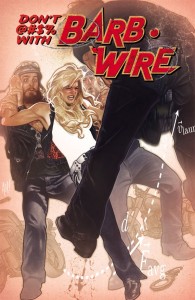 the terse dialogue, makes the book a fast read — but then, the reader has to go back and read it again, and stop to admire the splash pages and dainty figure work, and end up deciding that there’s more here than it seemed at first glance. Will Eisner’s The Spirit is exactly that, a 1940’s-set relaunch of the hardboiled crimefighter; Matt Wagner’s script (involving the lead character having been missing for two years) hits all the right notes, but artist Dan Schkade has the impossible task of trying to follow one of the absolute early masters of the comics field, and he’s not up to the task (no one is, although Eric Powell’s loose-limbed, two-fisted pulpish cover comes closer than most), meaning that this attempt is
the terse dialogue, makes the book a fast read — but then, the reader has to go back and read it again, and stop to admire the splash pages and dainty figure work, and end up deciding that there’s more here than it seemed at first glance. Will Eisner’s The Spirit is exactly that, a 1940’s-set relaunch of the hardboiled crimefighter; Matt Wagner’s script (involving the lead character having been missing for two years) hits all the right notes, but artist Dan Schkade has the impossible task of trying to follow one of the absolute early masters of the comics field, and he’s not up to the task (no one is, although Eric Powell’s loose-limbed, two-fisted pulpish cover comes closer than most), meaning that this attempt is 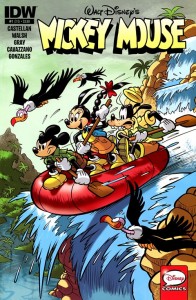 unlikely to fare any better than the others that have been tried over the last few decades. Barb Wire is a reboot, too, of the bar owner/bounty hunter who had some brief pop-culture fame with a middling movie starring Pamela Anderson in the ’90s; it has the advantage of being written by original series creator Chris Warner, who puts his heroine through standard-but-enjoyable-enough paces. That leaves Mickey Mouse, which, like its companion books Donald Duck and Uncle Scrooge, uses mostly-European creators to tell the adventures of its plucky rodent hero; at $3.99 for 48 full-color, glossy pages, it’s an attractive comic for fans and younger readers, and a welcome return to the stands for its title character.
unlikely to fare any better than the others that have been tried over the last few decades. Barb Wire is a reboot, too, of the bar owner/bounty hunter who had some brief pop-culture fame with a middling movie starring Pamela Anderson in the ’90s; it has the advantage of being written by original series creator Chris Warner, who puts his heroine through standard-but-enjoyable-enough paces. That leaves Mickey Mouse, which, like its companion books Donald Duck and Uncle Scrooge, uses mostly-European creators to tell the adventures of its plucky rodent hero; at $3.99 for 48 full-color, glossy pages, it’s an attractive comic for fans and younger readers, and a welcome return to the stands for its title character.
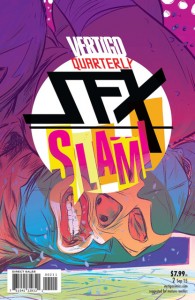 Vertigo Quarterly SFX #2 — Creators: Various
Vertigo Quarterly SFX #2 — Creators: Various
Not a first issue, strictly, but as an anthology it’s almost the same thing. “SFX” stands for “sound effects,” and the comic’s conceit is that each of its stories has to use the sound “Slam” (the first issue, last spring, had everyone required to use “Pop”) as part of some critical plot device or moment. This kind of thing rises and falls, of course, on the strength of its creative teams, and Vertigo typically provides a good mix of veterans, rookies and up-and-comers. The most interesting of the nine eight-pagers here have art by Andi Watson, Meredith Gran and Adam Cadwell; they all feature cartoony reactions taken partly from manga and partly from TV cartoons, and precise panel compositions and clear lines that owe a lot to the Hernandez brothers; they represent a trend in modern comics that’s showing up both at DC (with Batgirl and Black Canary), Marvel (Squirrel Girl) and indy publishers (Lumberjanes). Mix in a Mike Carey-written tale, “Schrodinger’s Catflap,” that wouldn’t have been out of place in a ’60s issue of Fantasy and Science Fiction, plus two effective horror stories (one by Will Pfeiffer and Scott Hepburn; the other by Mark Rahner and Joe Eisma), a Shelly Bond-drawn story about “seeing” music, and two other tales, and this is well worth its $7.99 cover price.
 Action Comics #42 — Writer: Greg Pak; Art: Aaron Kuder; Colors: Tomeu Morey, Hi-Fi and Blond
Action Comics #42 — Writer: Greg Pak; Art: Aaron Kuder; Colors: Tomeu Morey, Hi-Fi and Blond
The Unbeatable Squirrel Girl #7 — Writer: Ryan North; Art: Erica Henderson; Colors: Rico Renzi
The Wicked and the Divine # 12 — Writer: Kieron Gillen; Art/Colors: Kate Brown
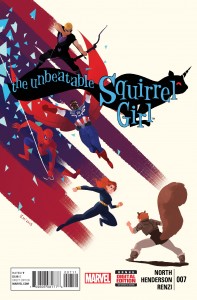 War Stories #10 — Writer: Garth Ennis; Art: Tomas Aira; Color: Digikore Studios
War Stories #10 — Writer: Garth Ennis; Art: Tomas Aira; Color: Digikore Studios
The Outcast #10 — Writer: Robert Kirkman; Art: Paul Azaceta; Colors: Elizabeth Breitweiser
Miami Vice #5 (of 5) — Writer: Joe Casey; Art: Jim 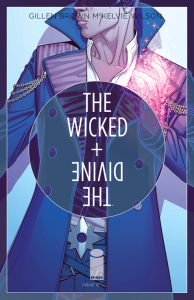 Mahfood; Colors: Justin Stewart and Steven Chunn
Mahfood; Colors: Justin Stewart and Steven Chunn
Airboy #2 — Writer: James Robinson; Art/Colors: Greg Hinkle
Satellite Sam #15 — Writer: Matt Fraction; Art: Howard  Chaykin
Chaykin
Minimum Wage #3 — Writer/Artist: Bob Fingerman
These come under the ongoing-series-I’ve-already-reviewed heading, so just a few words about each one: Action continues its Superman-as-vastly-depowered-fugitive story, a development that’s shaken a lot of dust off 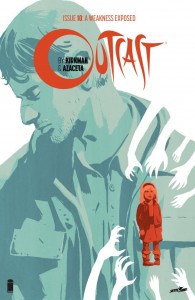 the character; my only problem with it is the way the Metropolis police act so viciously out of character that it suggests mind control or some other excuse (if this whole thing turns out to be a prank from Mxyzptlk, I promise to stop reading Superman books for a year…). Squirrel Girl we were just talking about, with its tongue firmly in its pouched cheek and with attitude to burn, while The Wicked and the Divine is its opposite, as serious as an exploding
the character; my only problem with it is the way the Metropolis police act so viciously out of character that it suggests mind control or some other excuse (if this whole thing turns out to be a prank from Mxyzptlk, I promise to stop reading Superman books for a year…). Squirrel Girl we were just talking about, with its tongue firmly in its pouched cheek and with attitude to burn, while The Wicked and the Divine is its opposite, as serious as an exploding 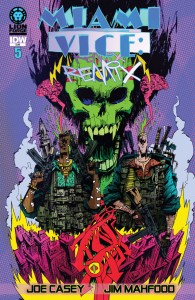 head; it’s starting a new arc where a different artist will cover events from a different character’s perspective in each issue, with Kate Brown kicking it off (two of the other upcoming artists, Brandon Graham and Tula Lotay, indicate the high quality in play here). War Stories is quality Ennis, as always, and begins a three-issue
head; it’s starting a new arc where a different artist will cover events from a different character’s perspective in each issue, with Kate Brown kicking it off (two of the other upcoming artists, Brandon Graham and Tula Lotay, indicate the high quality in play here). War Stories is quality Ennis, as always, and begins a three-issue  look at a bickering band-of-brothers-ish British Army regiment near the Reichswald in the later stages of WW II. Outcast moves its quietly-horrific demon-possession plot along, while filling in some of its main character’s past (including the apparent exorcism that estranged him from his wife and daughter — although why he couldn’t just tell them the truth about what happened is never made clear). Miami Vice: Remix concludes its psychedelic/underground/drug dealer/zombies season, and
look at a bickering band-of-brothers-ish British Army regiment near the Reichswald in the later stages of WW II. Outcast moves its quietly-horrific demon-possession plot along, while filling in some of its main character’s past (including the apparent exorcism that estranged him from his wife and daughter — although why he couldn’t just tell them the truth about what happened is never made clear). Miami Vice: Remix concludes its psychedelic/underground/drug dealer/zombies season, and 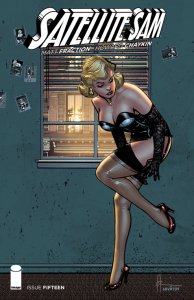 leaves the door open for another one later; Airboy offers the second chapter of its meta-textual look at its debauched writer and artist, as they attempt to write an Airboy comic, and fail miserably — until the fictional title character appears in their hotel room; look at the detail in
leaves the door open for another one later; Airboy offers the second chapter of its meta-textual look at its debauched writer and artist, as they attempt to write an Airboy comic, and fail miserably — until the fictional title character appears in their hotel room; look at the detail in 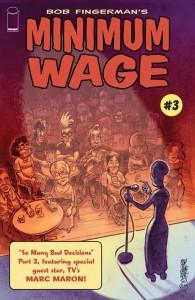 that Hinkle-drawn cover, and its perfect use of color — and then understand that the whole book is like that. Satellite Sam concludes its run with a flourish, tying up all its loose ends and giving everyone just the outcome they deserve (Howard Chaykin art!), and, finally, Minimum Wage continues its narrative about a divorced twenty-something cartoonist in turn-of-the-century New York City, and his disastrous dating life; it too offers precise art with a keen eye for caricature, and a semi-autobiographical ring of truth.
that Hinkle-drawn cover, and its perfect use of color — and then understand that the whole book is like that. Satellite Sam concludes its run with a flourish, tying up all its loose ends and giving everyone just the outcome they deserve (Howard Chaykin art!), and, finally, Minimum Wage continues its narrative about a divorced twenty-something cartoonist in turn-of-the-century New York City, and his disastrous dating life; it too offers precise art with a keen eye for caricature, and a semi-autobiographical ring of truth.



